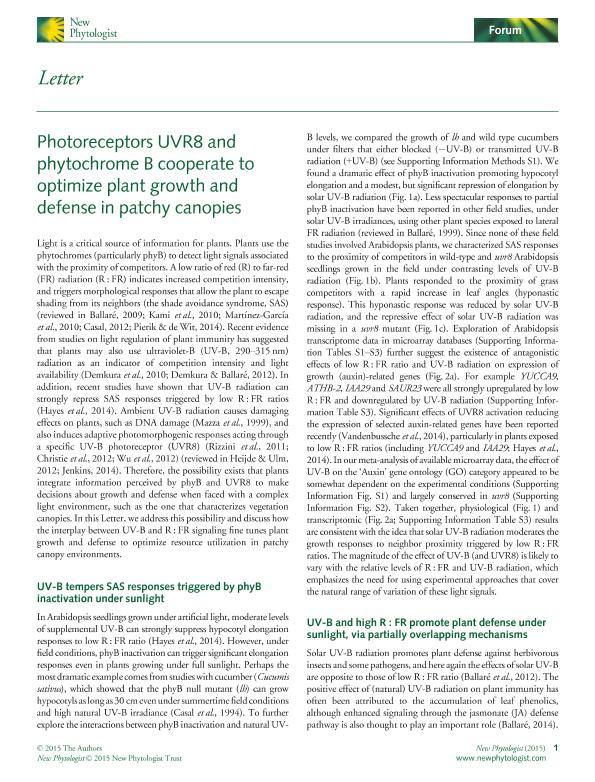Mostrar el registro sencillo del ítem
dc.contributor.author
Mazza, Carlos Alberto

dc.contributor.author
Ballare, Carlos Luis

dc.date.available
2016-02-11T19:36:13Z
dc.date.issued
2015-02
dc.identifier.citation
Mazza, Carlos Alberto; Ballare, Carlos Luis; Photoreceptors UVR8 and phytochrome B cooperate to optimize plant growth and defense in patchy canopies; Wiley; New Phytologist; 207; 1; 2-2015; 4-9
dc.identifier.issn
0028-646X
dc.identifier.uri
http://hdl.handle.net/11336/4145
dc.description.abstract
Light is a critical source of information for plants. Plants use the phytochromes (particularly phyB) to detect light signals associated with the proximity of competitors. A low ratio of red (R) to far-red (FR) radiation (R:FR) indicates increased competition intensity, and triggers morphological responses that allow the plant to escape shading from its neighbors (the shade avoidance syndrome, SAS). Recent evidence from studies on light regulation of plant immunity has suggested that plants may also use ultraviolet-B (UV-B, 290-315 nm) radiation as an indicator of competition intensity and light availability. In addition, recent studies have shown that UV-B radiation can strongly repress SAS responses triggered by low R:FR ratios. Ambient UV-B radiation causes damaging effects on plants, such as DNA damage, and also induces adaptive photomorphogenic responses acting through a specific UV-B photoreceptor (UVR8). Therefore, the possibility exists that plants integrate information perceived by phyB and UVR8 to make decisions about growth and defense when faced with a complex light environment, such as the one that characterizes vegetation canopies. In this Letter, we address this possibility and discuss how the interplay between UV-B and R:FR signaling fine tunes plant growth and defense to optimize resource utilization in patchy canopy environments.
dc.format
application/pdf
dc.language.iso
eng
dc.publisher
Wiley

dc.rights
info:eu-repo/semantics/openAccess
dc.rights.uri
https://creativecommons.org/licenses/by-nc-sa/2.5/ar/
dc.subject
Uvr8
dc.subject
Phytochrome
dc.subject
Auxin
dc.subject
Jasmonate
dc.subject.classification
Bioquímica y Biología Molecular

dc.subject.classification
Ciencias Biológicas

dc.subject.classification
CIENCIAS NATURALES Y EXACTAS

dc.title
Photoreceptors UVR8 and phytochrome B cooperate to optimize plant growth and defense in patchy canopies
dc.type
info:eu-repo/semantics/article
dc.type
info:ar-repo/semantics/artículo
dc.type
info:eu-repo/semantics/publishedVersion
dc.date.updated
2016-03-30 10:35:44.97925-03
dc.journal.volume
207
dc.journal.number
1
dc.journal.pagination
4-9
dc.journal.pais
Estados Unidos

dc.journal.ciudad
Hoboken
dc.description.fil
Fil: Mazza, Carlos Alberto. Consejo Nacional de Investigaciones Científicas y Técnicas. Oficina de Coordinación Administrativa Parque Centenario. Instituto de Investigaciones Fisiológicas y Ecológicas Vinculadas a la Agricultura; Argentina
dc.description.fil
Fil: Ballare, Carlos Luis. Consejo Nacional de Investigaciones Científicas y Técnicas. Oficina de Coordinación Administrativa Parque Centenario. Instituto de Investigaciones Fisiológicas y Ecológicas Vinculadas a la Agricultura; Argentina. Consejo Nacional de Investigaciones Científicas y Técnicas. Centro Científico Tecnológico La Plata. Instituto de Investigaciones Biotecnológicas - Instituto Tecnológico Chascomús. Instituto de Investigaciones Biotecnológicas (sede Chascomús); Argentina
dc.journal.title
New Phytologist

dc.relation.alternativeid
info:eu-repo/semantics/altIdentifier/purl/http://onlinelibrary.wiley.com/doi/10.1111/nph.13332/abstract
dc.relation.alternativeid
info:eu-repo/semantics/altIdentifier/issn/0028-646X
dc.relation.alternativeid
info:eu-repo/semantics/altIdentifier/doi/http://dx.doi.org/DOI:10.1111/nph.13332
Archivos asociados
